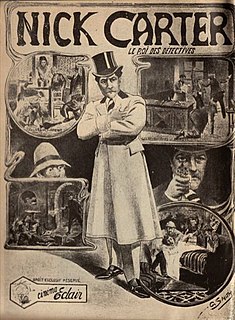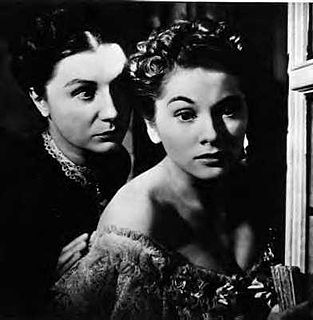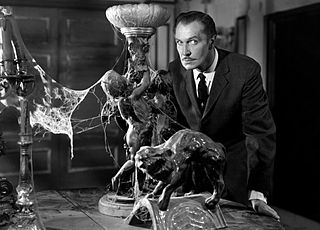Related Research Articles

A horror film is one that seeks to elicit fear or disgust in its audience for entertainment purposes. Horror films additionally aim to evoke viewers' nightmares, revulsions and terror of the unknown or the macabre. Initially inspired by literature from authors such as Edgar Allan Poe, Bram Stoker, and Mary Shelley, horror has existed as a film genre for more than a century. Horror may also overlap with the fantasy, supernatural fiction, and thriller genres.

Horror is a genre of speculative fiction which is intended to frighten, scare, or disgust. Literary historian J. A. Cuddon defined the horror story as "a piece of fiction in prose of variable length... which shocks, or even frightens the reader, or perhaps induces a feeling of repulsion or loathing". Horror intends to create an eerie and frightening atmosphere for the reader. Horror is often divided into the psychological horror and supernatural horror sub-genres. Often the central menace of a work of horror fiction can be interpreted as a metaphor for the larger fears of a society. Prevalent elements include ghosts, demons, vampires, werewolves, ghouls, the Devil, witches, monsters, dystopian and apocalyptic worlds, serial killers, cannibalism, psychopaths, cults, dark magic, Satanism, the macabre, gore, and torture.
Psychological horror is a subgenre of horror and psychological fiction with a particular focus on mental, emotional, and psychological states to frighten, disturb, or unsettle its audience. The subgenre frequently overlaps with the related subgenre of psychological thriller, and often uses mystery elements and characters with unstable, unreliable, or disturbed psychological states to enhance the suspense, drama, action, and paranoia of the setting and plot and to provide an overall unpleasant, unsettling, or distressing atmosphere.

A mystery film is a genre of film that revolves around the solution of a problem or a crime. It focuses on the efforts of the detective, private investigator or amateur sleuth to solve the mysterious circumstances of an issue by means of clues, investigation, and clever deduction.
In literature, psychological fiction is a narrative genre that emphasizes interior characterization and motivation to explore the spiritual, emotional, and mental lives of the characters. The mode of narration examines the reasons for the behaviors of the character, which propel the plot and explain the story. Psychological realism is achieved with deep explorations and explanations of the mental states of the character's inner person, usually through narrative modes such as stream of consciousness and flash back.
Psychological thriller is a genre combining the thriller and psychological fiction genres. It is commonly used to describe literature or films that deal with psychological narratives in a thriller or thrilling setting.
The horror-of-the-demonic film is one of three subgenres of the horror film that grew out of mid- and late-20th-century American culture.
The New Tenant is a play written by Eugène Ionesco in 1953, translated by Donald Watson in 1956, It premiered in 1955 in Lilla Teatern in Helsinki, Finland, directed by Vivica Bandler.
Supernatural horror film is a film genre that combines aspects of horror film and supernatural film. Supernatural occurrences in such films often include ghosts and demons, and many supernatural horror films have elements of religion. Common themes in the genre are the afterlife, the Devil, and demonic possession. Not all supernatural horror films focus on religion, and they can have "more vivid and gruesome violence".
Chris Furrh is an American former child actor, known for starring as Jack Merridew in the 1990 film adaptation of Lord of the Flies. After Lord of the Flies, he played the role of Nick Bankston in the 1990 telefilm A Family for Joe and, like in Lord of the Flies, he played Tommy, a castaway teenager in The Wonderful World of Disney film Exile. In 1989, Furrh retired from acting.

In film and television, drama is a category of narrative fiction intended to be more serious than humorous in tone. Drama of this kind is usually qualified with additional terms that specify its particular super-genre, macro-genre, or micro-genre, such as soap opera, police crime drama, political drama, legal drama, historical drama, domestic drama, teen drama, and comedy-drama (dramedy). These terms tend to indicate a particular setting or subject-matter, or else they qualify the otherwise serious tone of a drama with elements that encourage a broader range of moods.

Thriller film, also known as suspense film or suspense thriller, is a broad film genre that evokes excitement and suspense in the audience. The suspense element found in most films' plots is particularly exploited by the filmmaker in this genre. Tension is created by delaying what the audience sees as inevitable, and is built through situations that are menacing or where escape seems impossible.

Mai Tachihara is a Japanese actress. She appeared in Ring: Kanzenban, the 1995 TV movie adaptation of Koji Suzuki's novel Ring.
Phyllis MacMahon is an Irish actress. She is known for her work in films such as 10 Rillington Place (1971) in which she played Muriel Eady, the first woman murdered in the film by Richard Attenborough's John Christie, Leo the Last (1970), I Don't Want to Be Born (1975), The Magdalene Sisters (2002) and Shaun of the Dead (2004). She also played an Irish nurse in John Mackenzie's Made (1972). She typically plays nuns, prostitutes or old aunts.
Ray Barron was a British actor. He typically played minor roles such as policemen or workmen. He was known for his work in films such as 10 Rillington Place (1971) in which he played a workman, Poor Cow (1967), She'll Follow You Anywhere (1971) and Cry Uncle! (1971). In 1976 he appeared in Doctor Who as Sergeant Henderson in parts five and six of the serial The Seeds of Doom, and in 1981 played a seaman in the series The Incredible Mr Tanner.

Carl E. Guthrie was an American cinematographer.
Armond Lebowitz was an American film editor. He worked in many films by Larry Cohen, such as Q - The Winged Serpent (1982) and Perfect Strangers (1984). He also edited Ladybug Ladybug (1963), Too Many Thieves (1966), The Incident (1967), and A Midsummer Night's Dream (1967).
References
- ↑ Dead Ringers, A Gender and Genre Analysis: Horror of Personality Archived 2014-05-22 at the Wayback Machine
- ↑ "In Depth: Psychological Effect Of Horror Films". youthvoices.net.
- ↑ Charles Derry, Dark Dreams: A Psychological History of the Modern Horror Film; A S Barnes & Co, 1977.
- ↑ "Horror-of-personality film - Other early examples include". horrorcrime.com.